Opel Crossland X 2019 Owner's Manual
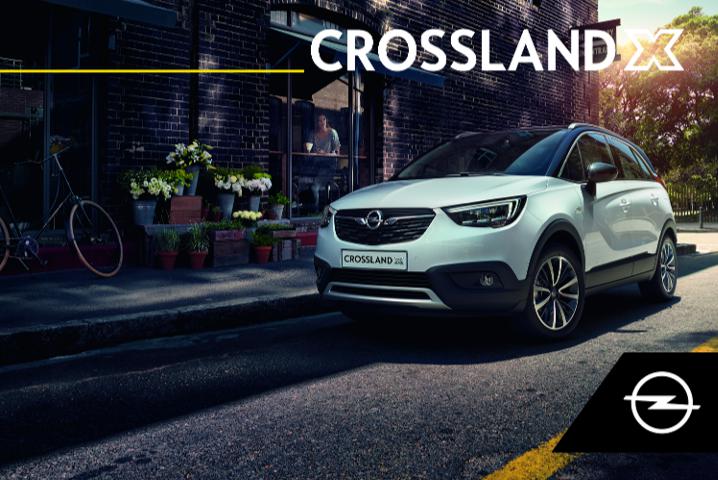
Owner's Manual

Contents
Introduction .................................... |
2 |
In brief ............................................ |
6 |
Keys, doors and windows ............ |
21 |
Seats, restraints ........................... |
42 |
Storage ........................................ |
63 |
Instruments and controls ............. |
72 |
Lighting ...................................... |
110 |
Climate control ........................... |
119 |
Driving and operating ................. |
131 |
Vehicle care ............................... |
187 |
Service and maintenance .......... |
227 |
Technical data ........................... |
233 |
Customer information ................ |
245 |
Index .......................................... |
256 |

2Introduction
Introduction

Introduction 3
Vehicle specific data
Please enter your vehicle's data on the previous page to keep it easily accessible. This information is available in the sections "Service and maintenance" and "Technical data" as well as on the identification plate.
Introduction
Your vehicle is a designed combination of advanced technology, safety, environmental friendliness and economy.
This Owner's Manual provides you with all the necessary information to enable you to drive your vehicle safely and efficiently.
Make sure your passengers are aware of the possible risk of accident and injury which may result from improper use of the vehicle.
You must always comply with the specific laws and regulations of the country that you are in. These laws may differ from the information in this Owner's Manual.
Disregarding the description given in this manual may affect your warranty.
When this Owner's Manual refers to a workshop visit, we recommend your Opel Service Partner. For gas vehicles, we recommend an Opel Repairer authorised for servicing gas vehicles.
All Opel Service Partners provide first-class service at reasonable prices. Experienced mechanics trained by Opel work according to specific Opel instructions.
The customer literature pack should always be kept ready to hand in the vehicle.
Using this manual
●Thismanualdescribesalloptions and features available for this model. Certain descriptions, including those for display and menu functions, may not apply to your vehicle due to model variant, country specifications, special equipment or accessories.
●The"Inbrief"sectionwillgiveyou an initial overview.
●The table of contents at the beginning of this manual and within each section shows where the information is located.
●The index will enable you to search for specific information.
●ThisOwner'sManualdepictslefthand drive vehicles. Operation is similar for right-hand drive vehicles.
●The Owner's Manual uses the engine identifier code. The corresponding sales designation and engineering code can be found in the section "Technical data".
●Directional data, e.g. left or right, or front or back, always relate to the direction of travel.
●Displays may not support your specific language.
●Display messages and interior labelling are written in bold letters.

4Introduction
Danger, Warnings and
Cautions
9 Danger
Text marked 9 Danger provides information on risk of fatal injury. Disregarding this information may endanger life.
9 Warning
Text marked 9 Warning provides information on risk of accident or injury. Disregarding this information may lead to injury.
Caution
Text marked Caution provides informationonpossibledamageto the vehicle. Disregarding this information may lead to vehicle damage.
Symbols
Page references are indicated with 3. 3 means "see page".
Chronological order to select menu entries in the vehicle personalisation is indicated with I.
Page references and index entries refer to the indented headings given in the section table of content.
We wish you many hours of pleasurable driving.
Your Opel Team

Introduction 5
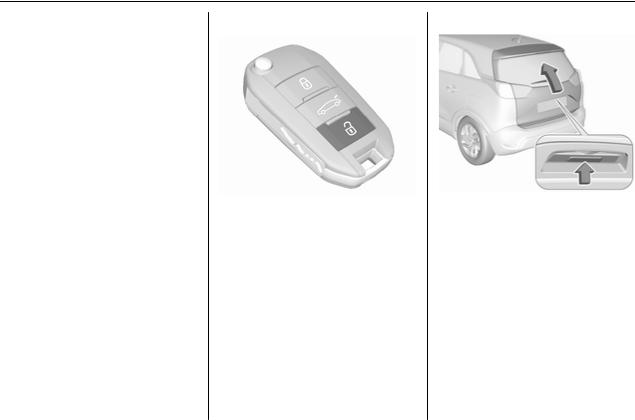
6In brief
In brief
Initial drive information
Vehicle unlocking
Press cto unlock the doors and load compartment. Open the doors by pulling the handles.
Press P to unlock the tailgate only.
Tailgate
After unlocking, press the touchpad switch above the licence plate and open the tailgate.
Radio remote control 3 22. Central locking system 3 24. Electronic key system 3 23. Load compartment 3 30.
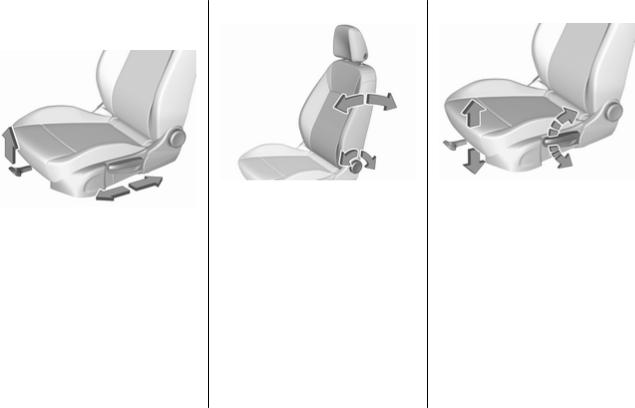
In brief |
7 |
Seat adjustment
Longitudinal adjustment
Pull handle, slide seat, release handle.Trytomovetheseatbackand forth to ensure that the seat is locked in place.
Seat position 3 43. Seat adjustment 3 44.
Backrests inclination
Turn handwheel. Do not lean on backrest when adjusting.
Seat position 3 43. Seat adjustment 3 44.
Seat height
Lever pumping motion
up |
: |
seat higher |
down |
: |
seat lower |
Seat position 3 43. Seat adjustment 3 44.

8In brief
Seat inclination
Press switch
top |
: |
front end higher |
bottom |
: |
front end lower |
Seat position 3 43. Seat adjustment 3 44.
Head restraint adjustment |
Seat belt |
Press release button, adjust height, |
Pullouttheseatbeltandfasteninbelt |
engage. |
buckle. The seat belt must not be |
Head restraints 3 42. |
twisted and must fit close against the |
|
body. The backrest must not be tilted |
|
back too far (maximum approx. 25°). |
|
To unfasten belt, press red button on |
|
belt buckle. |
|
Seat position 3 43. |
|
Seat belts 3 48. |
|
Airbag system 3 51. |

In brief |
9 |
Mirror adjustment
Interior mirror
To adjust the mirror, move the mirror housing in the desired direction.
Manual anti-dazzle interior mirror 3 36.
Automatic anti-dazzle interior mirror 3 36.
Exterior mirrors
Select the relevant exterior mirror by pushing the mirror button to the left or right. Adjust respective mirror by the four-way control.
Convex mirrors 3 34. Electric adjustment 3 34. Folding mirrors 3 35. Heated mirrors 3 35.
Steering wheel adjustment
Unlock lever, adjust steering wheel, then engage lever and ensure it is fully locked. Do not adjust steering wheelunlessvehicleisstationaryand steering wheel lock has been released.
Seat position 3 43. Ignition positions 3 132.
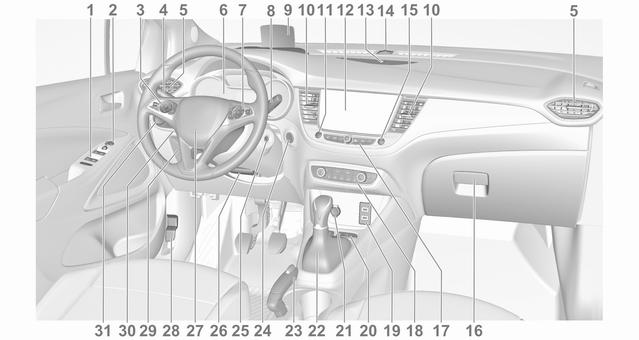
10 |
In brief |
Instrument panel overview
|
|
|
|
|
|
|
|
|
In brief |
11 |
1 |
Power windows |
37 |
|
12 |
Info Display |
97 |
|
25 |
Ignition switch |
132 |
|
|
|||||||||
2 |
Exterior mirrors ..................... |
34 |
|
13 |
Centre air vent ...................... |
97 |
|
26 |
Steering wheel adjustment . |
. 73 |
3 |
Cruise control ..................... |
151 |
|
14 |
Anti-theft alarm system |
|
|
27 |
Horn ..................................... |
74 |
|
Speed limiter ....................... |
153 |
|
|
status LED ........................... |
32 |
|
28 |
Bonnet release lever .......... |
189 |
4 |
Turn lights ........................... |
114 |
|
15 |
Central locking system .......... |
24 |
|
29 |
Storage ................................. |
63 |
|
Headlight flash |
111 |
|
16 |
Glovebox .............................. |
63 |
|
|
Fuse box |
204 |
|
|
|
Fuse box |
204 |
|
|
||||
|
High beam |
111 |
|
|
|
30 |
Head-up display .................... |
99 |
||
|
|
17 |
Controls for Info Display |
|
|
31 |
Light switch |
110 |
||
|
|
|
|
|
|
|||||
|
High beam assist ............... |
112 |
|
|
operation ............................... |
97 |
|
|||
|
Exit lighting |
117 |
|
18 |
Climate control system |
120 |
|
|
Headlight range |
|
|
|
|
|
adjustment ......................... |
112 |
|||||
|
Parking lights ...................... |
115 |
|
19 |
USB charging port ................ |
77 |
|
|
Front / rear fog lights .......... |
114 |
|
|
|
|
20 |
Parking assist / Advanced |
|
|
|
|
|
|
Buttons for Driver |
95 |
|
|
parking assist ..................... |
161 |
|
|
Instrument illumination ....... |
116 |
|
Information Centre ................ |
|
|
Lane departure warning |
175 |
|
|
|
|
|
5 |
Side air vents |
127 |
|
|
|
|
|
|
||
|
|
Eco button for stop-start |
|
|
|
|
|
|||
6 |
Instruments |
84 |
|
|
|
|
|
|
|
|
|
|
system |
137 |
|
|
|
|
|||
|
Driver Information Centre |
95 |
|
|
|
|
|
|
||
|
|
|
Electronic Stability Control |
|
|
|
|
|
||
7 |
Infotainment controls |
|
|
|
|
|
|
|
|
|
|
|
|
and Traction Control ........... |
149 |
|
|
|
|
||
8 |
Windscreen wiper and |
|
|
21 |
Power outlet .......................... |
77 |
|
|
|
|
|
washer, rear wiper and |
|
|
22 |
Manual transmission |
147 |
|
|
|
|
|
washer ................................. |
74 |
|
|
|
|
|
|||
9 |
Head-up display .................... |
99 |
|
|
Automatic transmission ...... |
144 |
|
|
|
|
10 |
Centre air vents .................. |
127 |
|
23 |
Manual parking brake ......... |
148 |
|
|
|
|
11 |
Hazard warning flashers .... |
113 |
|
24 |
Power button ....................... |
133 |
|
|
|
|
|
|
|
|
|
|
|
|
|
|
|
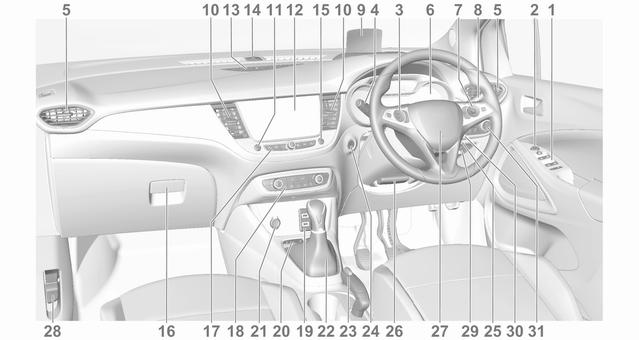
12 |
In brief |
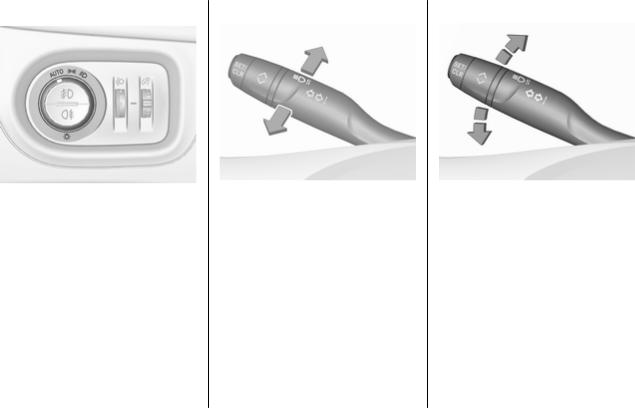
In brief |
13 |
Exterior lighting
AUTO : automatic light control switches automatically between daytime running light and headlight
8 : sidelights
9 : headlights Automatic light control 3 111.
Fog lights
Press button in light switch: > : front fog lights
ø : rear fog light
Headlight flash and high beam |
Turn lights |
pull stalk |
: headlight flash |
stalk up |
: right turn light |
push stalk |
: high beam |
stalk down |
: left turn light |
High beam 3 111. |
Turn lights 3 114. |
||
High beam assist 3 112. |
Parking lights 3 115. |
||
Headlight flash 3 111.
Adaptive forward lighting 3 112.

14 In brief
Hazard warning flashers |
Horn |
Washer and wiper systems |
|
|
Windscreen wiper |
Operated by pressing ¨. |
Press j. |
|
Hazard warning flashers 3 113. |
HI |
: fast |
|
||
|
LO |
: slow |
|
INT |
: interval wiping |
or
AUTO : automatic wiping with rain sensor
OFF : off
For single wipe when the wiper is off, press lever down to position 1x.
Windscreen wiper 3 74.
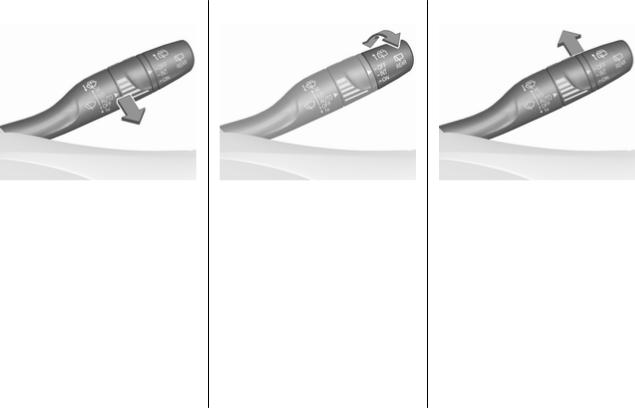
In brief |
15 |
Windscreen washer
Pull lever.
Windscreen washer system 3 74. Washer fluid 3 191.
Wiper blade replacement 3 194.
Rear window wiper
Turn outer cap to activate the rear window wiper:
OFF |
: off |
INT |
: intermittent operation |
ON |
: continuous operation |
Rear window washer
Push lever.
Washer fluid is sprayed on the rear window and the wiper wipes a few times.
Rear window wiper / washer 3 76.
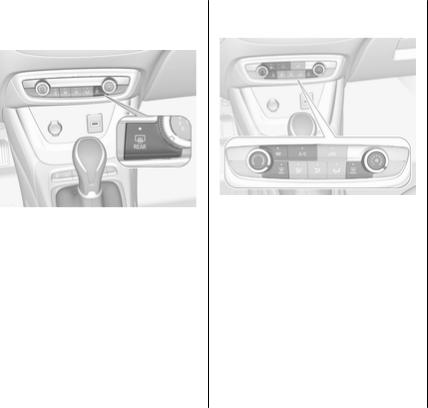
16 |
In brief |
Climate control
Heated rear window
The heating is operated by pressing b.
Heated rear window 3 38. Heated exterior mirrors 3 35.
Demisting and defrosting the |
Electronic climate control system |
windows |
3 123. |
|
Heating and ventilation system |
|
3 119. |
|
Air conditioning system 3 120. |
|
Heated windscreen 3 39. |
●Press à: the air distribution is directed towards the windscreen.
●Settemperaturecontroller£ to warmest level.
●Switch on air conditioning A/C if required.
●Set fan speed Z to highest level.
●Switchon heatedrear window b.
●Switch on heated windscreen ,.
●Open side air vents as required and direct them towards the door windows.

In brief |
17 |
Transmission
Manual transmission
To engage reverse on 6-speed transmission, depress the clutch pedal, pull the ring under the selector lever and move the selector lever to the left and front.
Manual transmission 3 147.
Automatic transmission
P : park position R : reverse
N : neutral mode D : automatic mode M : manual mode < : upshift
] : downshift
Automatic transmission 3 144.
Starting off
Check before starting off
●tyre pressure 3 208 and condition 3 244
●engine oil level and fluid levels 3 190
●all windows, mirrors, exterior lighting and number plates are free from dirt, snow and ice and are operational
●proper position of mirrors 3 34, seats 3 43 and seat belts
3 49
●brake function at low speed, particularly if the brakes are wet

18 |
In brief |
Starting the engine
Ignition switch
●Turn key to position 1.
●Move the steering wheel slightly to release the steering wheel lock.
●Manual transmission: operate clutch and brake pedal.
Automatic transmission: operate brake pedal and move selector lever to P or N.
●Donotoperateacceleratorpedal.
●Diesel engine: wait until control indicator !for preheating extinguishes.
●Turn key to position 2 and release after engine has been started.
Starting the engine 3 135.
Power button
●Manual transmission: operate clutch and brake pedal.
●Automatic transmission: operate brake pedal and move selector lever to P or N.
●Donotoperateacceleratorpedal.
●Press Start/Stop button.
●Release button after starting procedure begins.

In brief |
19 |
Stop-start system
If the vehicle is at a low speed or at a standstill and certain conditions are fulfilled, an Autostop is activated.
An Autostop is indicated by control indicator D.
Manual transmission: to restart the engine, depress the clutch pedal again. Control indicator D
extinguishes.
Automatic transmission: to restart the engine, release the brake pedal. Control indicator D extinguishes.
Stop-start system 3 137.
Parking
9Warning
●Do not park the vehicle on an easily ignitable surface. The high temperature of the exhaustsystemcouldignitethe surface.
●Always apply the parking brake. Activate the manual parking brake without pressing the release button. Apply as firmly as possible on a downhill slope or uphill slope. Depress brake pedal at the same time to reduce operating force.
●Switch off the engine.
●If the vehicle is on a level surface or uphill slope, engage first gear or set the selector lever to position P before removing the ignition key or switching off ignition on vehicles with power button. On an uphill slope, turn the front wheels away from the kerb.
If the vehicle is on a downhill slope, engage reverse gear or settheselectorlevertoposition P before removing the ignition key or switching off ignition on vehicles with power button.
Turn the front wheels towards the kerb.
●Close the windows.
●Remove the ignition key from the ignition switch or switch off ignition on vehicles with power button. Turn the steering wheel until the steering wheel lock is felt to engage.
●Lock the vehicle with eon the radio remote control.
Activate the anti-theft alarm system 3 32.
●The engine cooling fans may run after the engine has been switched off 3 189.

20 |
In brief |
Caution
After running at high engine speeds or with high engine loads, operate the engine briefly at a low load or run in neutral for
approx. 30 seconds before switching off, in order to protect the turbocharger.
Keys, locks 3 21.
Laying-up the vehicle for a long period of time 3 188.
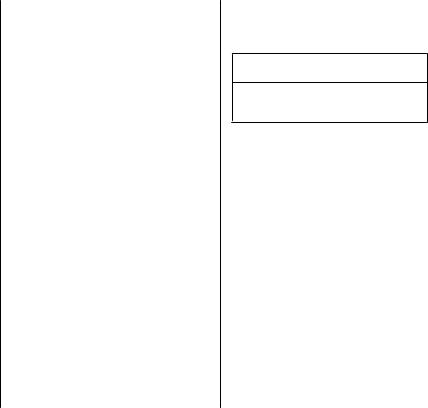
Keys, doors and windows |
21 |
Keys, doors and |
|
windows |
|
Keys, locks ................................... |
21 |
Keys .......................................... |
21 |
Radio remote control ................. |
22 |
Electronic key system ................ |
23 |
Central locking system .............. |
24 |
Automatic locking ...................... |
28 |
Child locks ................................. |
29 |
Doors ........................................... |
30 |
Load compartment .................... |
30 |
Vehicle security ............................ |
31 |
Anti-theft locking system ........... |
31 |
Anti-theft alarm system .............. |
32 |
Immobiliser ................................ |
34 |
Exterior mirrors ............................ |
34 |
Convex shape ........................... |
34 |
Electric adjustment .................... |
34 |
Folding mirrors .......................... |
35 |
Heated mirrors ........................... |
35 |
Interior mirrors ............................. |
36 |
Manual anti-dazzle .................... |
36 |
Automatic anti-dazzle ................ |
36 |
Windows ...................................... |
36 |
Windscreen ............................... |
36 |
Power windows ......................... |
37 |
Heated rear window .................. |
38 |
Heated windscreen .................... |
39 |
Sun visors .................................. |
40 |
Roof ............................................. |
40 |
Glass panel ............................... |
40 |
Keys, locks
Keys
Caution
Donotattachheavyorbulkyitems to the ignition key.
Replacement keys
The key number is specified on a detachable tag.
The key number must be quoted when ordering replacement keys as it is a component of the immobiliser system.
Locks 3 224. Central locking 3 24.
Starting the engine 3 135. Radio remote control 3 22. Electronic key 3 23.
The code number of the adapter for the locking wheel nuts is specified on a card. It must be quoted when ordering a replacement adapter.
Wheel changing 3 215.

22 Keys, doors and windows
Key with foldaway key section
Press button to extend. To fold the key, first press the button.
Radio remote control
Enables operation of the following functions via the use of the remote control buttons:
●central locking system 3 24
●anti-theft locking system 3 31
●anti-theft alarm system 3 32
●tailgate unlocking 3 24
●power windows 3 37
●mirrors folding
The remote control has a range of up to 100 m, but may also be much less due to external influences. The hazard warning flashers confirm operation.
Handle with care, protect from moisture and high temperatures and avoid unnecessary operation.
Replacing battery in radio remote control
Replace the battery as soon as the range reduces.
Batteries do not belong in household waste. They must be disposed of at an appropriate recycling collection point.
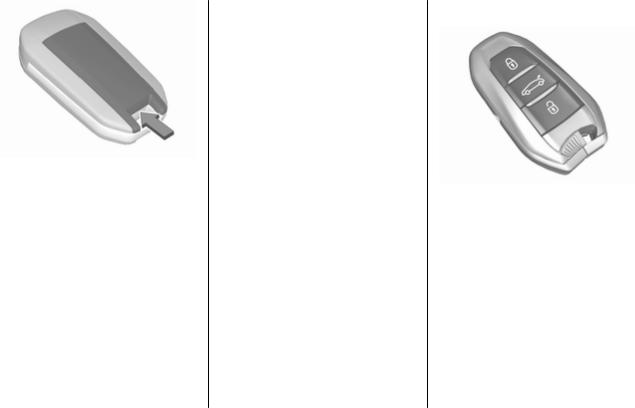
Keys, doors and windows |
23 |
1.To unclip the cover insert a small screwdriver between the back cover and the remote control.
2.Remove the back cover.
3.Extract the flat battery from its location.
4.Replace battery with a battery of the same type. Pay attention to the installation position.
5.Clip the cover in place.
Fault
If the central locking system cannot be operated with the radio remote control, the cause may be one of the following:
●Fault in radio remote control.
●The range is exceeded.
●The battery voltage is too low.
●Frequent, repeated operation of theradioremotecontrolwhilenot in range, which will require resynchronisation.
●Overload of the central locking system by operating at frequent intervals, the power supply is interrupted for a short time.
●Interference from higher-power radio waves from other sources.
Manual unlocking 3 24.
Electronic key system
Enables a keyless operation of the following functions:
●central locking system 3 24
●ignition switching on and starting the engine 3 135
Theelectronickeysimplyneedstobe on the driver's person.
Additionally, the electronic key includes the functionality of the radio remote control 3 22.
Handle with care, protect from moisture and high temperatures and avoid unnecessary operation.

24 Keys, doors and windows
Replacing battery in electronic key
Replace the battery as soon as the system no longer operates properly or the range is reduced. The need for battery replacement is indicated by a message in the Driver Information Centre 3 101.
Batteries do not belong in household waste. They must be disposed of at an appropriate recycling collection point.
1.To unclip the cover insert a small screwdriver in the cutout.
2.Remove the cover.
3.Extract the flat battery from its location.
4.Replace battery with a battery of the same type. Pay attention to the installation position.
5.Clip the cover in place.
Fault
If the central locking cannot be operated or the engine cannot be started, the cause may be one of the following:
●Fault in electronic key.
●Electronic key is out of reception range.
●The battery voltage is too low.
●Overload of the central locking system by operating at frequent intervals, the power supply is interrupted for a short time.
●Interference from higher-power radio waves from other sources.
To rectify the cause of the fault, change the position of the electronic key.
Manual unlocking 3 24.
Central locking system
Unlocks and locks doors, load compartment and fuel filler flap.
Pull an interior door handle fully to unlock and open the respective door.
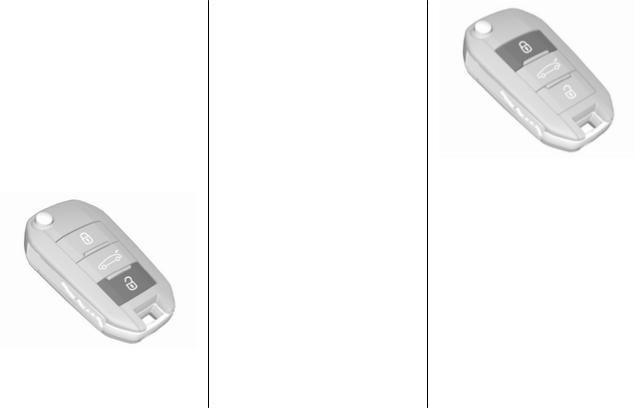
Keys, doors and windows |
25 |
Note
In the event of an accident in which airbags or belt pretensioners are deployed, the vehicle is automatically unlocked.
Note
A short time after unlocking with the remote control the doors are locked automatically if no door has been opened.
Remote control operation
Unlocking
Press O.
Unlocking mode can be set in the vehicle personalisation menu in the Info Display. Two settings are selectable:
●All doors, load compartment and fuel filler flap will be unlocked by pressing O once.
●Only the driver's door and fuel filler flap will be unlocked by pressing O once. To unlock all
doors, load compartment and fuel filler flap, press O twice.
Select the relevant setting in the Vehicle personalisation.
Vehicle personalisation 3 102.
Unlocking the tailgate
Press P longer to unlock the tailgate only.
Vehicle personalisation 3 102.
Unlocking and opening the tailgate 3 30.
Locking
Close doors, load compartment and fuel filler flap.
Press N.
If a door is not closed properly, the central locking system will not work.
Confirmation
Operation of the central locking system is confirmed by the hazard warning flashers.
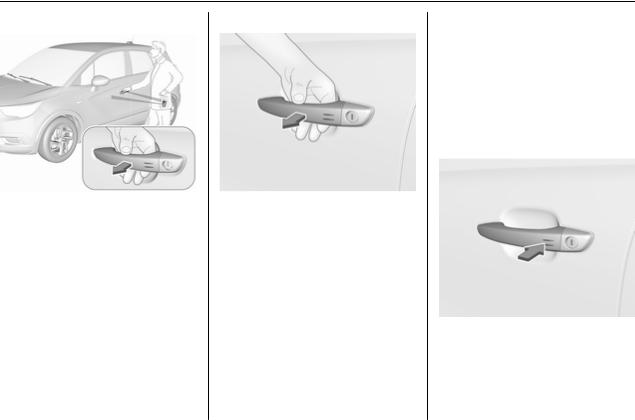
26 Keys, doors and windows
Electronic key system operation
The electronic key must be outside the vehicle, within a range of approx. 1 m of the relevant door side.
Unlocking
Pass your hand behind one of the front door handles to unlock the vehicle or press the tailgate button.
Unlocking mode can be set in the vehicle personalisation. Three settings are selectable:
●Only the driver's door and fuel filler flap will be unlocked by passing your hand behind the driver's door handle.
●All doors, load compartment and fuel filler flap will be unlocked by passing your hand behind one of the front door handles or by pressing the tailgate button.
●Only the tailgate will be unlocked by pressing the tailgate button.
Vehicle personalisation 3 102 Locking
Press with a finger or thumb on one of the front door handles (at the markings).
All doors, load compartment and fuel filler flap will be locked.

Keys, doors and windows |
27 |
The system locks if any door has been opened and all doors are now closed.
If the driver's door is not closed properly,theelectronickeyremainsin the vehicle or the ignition is not off, locking will not be permitted and a warning chime sounds.
If there have been two or more electronic keys in the vehicle and the ignitionwasononce,thedoorswillbe locked even if just one electronic key is taken out of the vehicle.
Unlocking and opening the tailgate
The tailgate can be unlocked and opened by pushing the touchpad under the tailgate moulding when the electronic key is in range. The doors remain locked depending on the configuration in the vehicle personalisation.
Load compartment 3 30 Vehicle personalisation 3 102
Operation with buttons on the electronic key
The central locking system can also be operated with the buttons on the electronic key.
Press O to unlock the driver's door
and the fuel filler flap or all doors, the fuel filler flap and the tailgate.
Press N to lock the driver's door and
the fuel filler flap or all doors, the fuel filler flap and the tailgate.
Press P longer to unlock and open
only the tailgate or all doors, the fuel filler flap and the tailgate.
Remote control operation 3 24.
Confirmation
Operation of central locking system is confirmed by the hazard warning flashers.
Central locking buttons
Locks or unlocks all doors, the load compartment and fuel filler flap from the passenger compartment via a switch.
PressQ tolock.TheLEDinthebutton illuminates.
Press Q again to unlock. The LED in the button extinguishes.

28 Keys, doors and windows
Operation with the key in case of a central locking system fault
In case of a fault, e.g. vehicle battery or remote control / electronic key battery is discharged, the driver's door can be locked or unlocked with the mechanical key.
Manual unlocking
Electronic key: press and hold the latch to extract the integral key.
Manually unlock the driver's door by inserting and turning the key in the lock cylinder.
The other doors can be opened by pulling the interior handle. The load compartment and fuel filler flap will possibly not be unlocked.
By switching on the ignition, the antitheft locking system is deactivated.
Manual locking
Manually lock the driver's door by inserting and turning the key in the lock cylinder.
To lock the other doors, first remove the black cover by inserting a key and turning clockwise.
Insert key into the recess and move latch sideways.
Remove key and attach the black cover.
The fuel filler flap and tailgate are possibly not locked.
Automatic locking
Automatic locking after driving off
This system allows automatic locking of the doors as soon as the speed of the vehicle exceeds 10 km/h.
